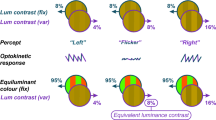Abstract
An interactive, computer-controlled, visual stimulus generator is described, suitable for both psychophysical and neurophysiological experimentation on human subjects. The system core is a wide-screen electrostatic cathode-ray tube, which can be used both as a television monitor, to display standard video pictures, and as anx-y oscilloscope, so that a bright dot can be moved around the display by electrical signals. In addition, a third working mode is provided, according to which a time-compressed video picture of limited size (fast picture) plays the role that is typical of the spot in a standard oscilloscope. Through computer-assisted time compression, the frame period of the video signal is reduced to about one tenth of its standard value. The fast picture can accordingly be driven by even the fastest eye movements, and it can be displayed as a stabilized image, or, more generally, in the altered retinal feedback condition. Moreover, as compared with a standard video picture, the fast image can be “flashed” over much shorter time periods. Since a standard input video signal is used for both standard and fast video pictures, all the image processing facilities of commercial videographic systems can be fully exploited by the proposed device.
Similar content being viewed by others
References
Carmody, D. P. (1985). Free search, restricted search, and the need for context in radiologic image perception. In R. Groner, G. W. McConkie, & C. Menz (Eds.),Eye movements and human information processing (pp. 341–357). Amsterdam: North-Holland.
Cornsweet, T. N., &Crane, H. D. (1973). Accurate two-dimensional eye tracker using first and fourth Purkinje images.Journal of the Optical Society of America,63, 921–928.
Cushman, W. B., Tangney, J. F., Steinman, R. M., &Ferguson, J. L. (1984). Characteristics of smooth eye movements with stabilized images.Vision Research,24, 1003–1009.
Ditchburn, R. W. (1983), Picture viewing and visual tracking—Introduction. In R. Groner, C. Menz, D. F. Fisher, & R. A. Monty (Eds.),Eye movements and psychological functions: International views (pp. 139–143). Hillsdale, NJ: Erlbaum.
Ditchburn, R. W., &Ginsborg, B. L. (1952). Vision with a stabilized retinal image.Nature,170, 36–37.
Intraub, H. (1985). Conceptual masking of briefly glimpsed photographs. In R. Groner, G. W. McConkie, & C. Menz (Eds.),Eye movements and human information processing (pp. 59–69). Amsterdam: North-Holland.
Jones, R. M., &Tulunay-Kjeesy, U. (1975). Accuracy of image stabilization by an optical-electronic feedback system.Vision Research,15, 57–61.
Jonides, J., Irwin, D. E., &Yantis, S. (1982). Integrating visual information from successive fixations.Science,215, 192–194.
Kelly, D. H. (1979). Motion and vision: I. Stabilized images of stationary gratings.Journal of the Optical Society of America,69, 1266–1274.
Llewellyn-Thomas, E. (1981). Can eye movements save the earth? In D. F. Fisher, R. A. Monty, & J. W. Senders (Eds.),Eye movements: Cognition and visual perception (pp. 317–321). New York: Wiley.
Lüer, G., &Lass, U., (Eds.) (1987).Fourth European Conference on Eye Movements: Vol. I. Proceedings (pp. 60–88). Lewiston, NY: C. Hogrefe.
McConkie, G. W., Zola, D., Wolverton, G. S., &Burns, D. D. (1978). Eye movement contingent display control in studying reading.Behavior Research Methods & Instrumentation,15, 154–166.
Neboit, M., &Richardson, J. (1987). Eye movement recording in ergonomics and applied research. In J. K. O’Regan & A. Lévy-Schoen (Eds.),Eye movements: From physiology to cognition (pp. 551–553). Amsterdam: North-Holland.
Nettleton, N. C., Wood, R. G., Bradshaw, J. L., Thomas, C. D. L., &Donahoo, K. B. (1983). A moving video window or mask yoked to eye movements: A system to permit free ocular scanning within delimited areas of the visual field.Behavior Research Methods & Instrumentation,15, 487–496.
Nodine, C. F., &McGinnis, J. J. (1979). A head-mounted display holder for eye movement recording.Behavior Research Methods á Instrumentation,11, 427–428.
Palmieri, G., Oliva, G. A., &Scotto, M. (1971). CRT. Spotfollower device for eye-movement measurements.Kybernetik,8, 23–30.
Palmieri, G., Scotto, M., &Oliva, G. A. (1974). Image-converter pattern tracker for variable retinal feedback experiments.Kybernetik,15, 193–202.
Pola, J., &Wyatt, H. J. (1985). Active and passive smooth eye movements: Effects of stimulus size and location.Vision Research,25, 1063–1076.
Scotto, M. (1989). Synchronization in open-loop sinusoidal tracking. In R. Schmid & D. Zambarbieri (Eds.),Fifth European Conference on Eye Movements: Proceedings (pp. 104–106). Pavia: University Press.
Scotto, M., Gagna, P. G., Nobile, M., Spadavecchia, L., &Masulli, F. (1988). Time-compressed video pictures for vision research.IEEE Transactions on Biomedical Engineering,35, 210–214.
Scotto, M., &Oliva, G. A. (1989). Synchronization of oscillatory eye movements and perceptual alternance. In R. Schmid & D. Zambarbieri (Eds.),Fifth European Conference on Eye Movements: Proceedings (pp. 199–201). Pavia: University Press.
Scotto, M. A.,Oliva, G. A., &Tuccio, M. T. (in press). Eye movements and reversal rates of ambiguous patterns.Perceptual & Motor Skills.
Smith, K. U., Putz, V., &Molitor, K. (1970). Delayed retinal feedback of eye movements: A dynamic basic of perceptual disabilities.Journal of Applied Psychology,54, 538–548.
Author information
Authors and Affiliations
Additional information
The authors wish to thank P. Gagna for his assistance and technical advice during implementation of the system.
Rights and permissions
About this article
Cite this article
Scotto, M., Nobile, M. A new approach to the generation of visual stimuli for eye-movement research. Behavior Research Methods, Instruments, & Computers 22, 323–330 (1990). https://doi.org/10.3758/BF03209824
Received:
Accepted:
Published:
Issue Date:
DOI: https://doi.org/10.3758/BF03209824




